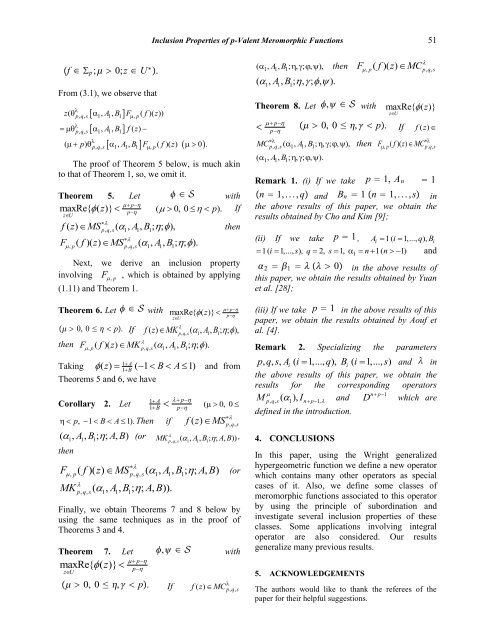TITLE MARCH 2012 - Pakistan Academy of Sciences
TITLE MARCH 2012 - Pakistan Academy of Sciences
TITLE MARCH 2012 - Pakistan Academy of Sciences
You also want an ePaper? Increase the reach of your titles
YUMPU automatically turns print PDFs into web optimized ePapers that Google loves.
Inclusion Properties <strong>of</strong> p-Valent Meromorphic Functions 51<br />
f p ; 0;z U .<br />
From (3.1), we observe that<br />
<br />
<br />
<br />
p<br />
f z<br />
<br />
<br />
p, q, s 1 1 1 ,<br />
z( , A , B F ( f )( z))<br />
<br />
p, q, s 1 A1 B1<br />
, , ( ) <br />
<br />
p, q, s 1 1 1 ,<br />
p<br />
( p) , A , B F ( f )( z) 0 .<br />
The pro<strong>of</strong> <strong>of</strong> Theorem 5 below, is much akin<br />
to that <strong>of</strong> Theorem 1, so, we omit it.<br />
Theorem 5. Let S with<br />
p<br />
maxRe{ ( z)}<br />
( 0, 0 <br />
p).<br />
If<br />
zU<br />
p<br />
f ( z) MS ( , A , B ; ; ),<br />
then<br />
<br />
p, q, s 1 1 1<br />
F ( f )( z) MS ( , A , B ; ; ).<br />
<br />
, p<br />
<br />
p, q, s<br />
1 1 1<br />
<br />
Next, we derive an inclusion property<br />
involving F <br />
, which is obtained by applying<br />
, p<br />
(1.11) and Theorem 1.<br />
Theorem 6. Let S with maxRe{ ( z )} <br />
zU<br />
p<br />
p<br />
0, 0 p.<br />
<br />
If f ( z) MK<br />
p, q, s( 1, A1 , B1<br />
; ; ),<br />
<br />
then F<br />
, p<br />
f z MK<br />
p, q, s 1<br />
A1 B1<br />
<br />
( )( ) ( , , ; ; ).<br />
1<br />
Taking ( z) A<br />
1B<br />
( 1 B A 1) and from<br />
Theorems 5 and 6, we have<br />
Corollary 2. Let<br />
1<br />
A<br />
1B<br />
( 0, 0 <br />
p<br />
p<br />
p, 1 B A 1).<br />
Then if f z MS <br />
<br />
, ,<br />
( , A , B ; ; A, B)<br />
(or<br />
then<br />
1 1 1<br />
<br />
p, q, s 1 1 1<br />
<br />
, p<br />
p, q, s<br />
1 1 1<br />
<br />
()<br />
p q s<br />
MK ( , A , B ; ; A, B))<br />
,<br />
F ( f )( z) MS ( , A , B ; ; A, B)<br />
(or<br />
MK ( , A , B ; ; A, B)).<br />
<br />
p, q, s 1 1 1<br />
Finally, we obtain Theorems 7 and 8 below by<br />
using the same techniques as in the pro<strong>of</strong> <strong>of</strong><br />
Theorems 3 and 4.<br />
Theorem 7. Let , S with<br />
p<br />
maxRe{ ( z)}<br />
<br />
zU<br />
p<br />
0, 0 , p. If f z MC <br />
, ,<br />
() p q s<br />
<br />
1 A1 B1<br />
then<br />
, p<br />
p, q,<br />
s<br />
( , , ; , ; , ),<br />
( , A, B; , ; , ).<br />
1 1 1<br />
F ( f )( z)<br />
MC<br />
Theorem 8. Let , S with maxRe{ ( z)}<br />
p<br />
<br />
p<br />
MC<br />
zU<br />
f z <br />
<br />
0, 0 , p. If ()<br />
<br />
p, q, s ( 1 , A1 , B1<br />
; , ; , ),<br />
1 1 1<br />
then F , p ( f )( z)<br />
MC <br />
, ,<br />
( , A, B; , ; , ).<br />
p q s<br />
Remark 1. (i) If we take p 1, A n 1<br />
n 1,...,q and B n 1 n 1,...,s in<br />
the above results <strong>of</strong> this paper, we obtain the<br />
results obtained by Cho and Kim [9];<br />
(ii) If we take p 1 , 1( 1,..., ),<br />
Ai<br />
i q Bi<br />
1( i 1,..., s), q 2, s 1, n 1( n 1) and<br />
2 1 0 in the above results <strong>of</strong><br />
this paper, we obtain the results obtained by Yuan<br />
et al. [28];<br />
(iii) If we take p 1 in the above results <strong>of</strong> this<br />
paper, we obtain the results obtained by Aouf et<br />
al. [4].<br />
Remark 2. Specializing the parameters<br />
p, q, s, Ai<br />
( i 1,..., q), Bi<br />
( i 1,..., s)<br />
and in<br />
the above results <strong>of</strong> this paper, we obtain the<br />
results for the corresponding operators<br />
<br />
n p 1<br />
M ( ), I<br />
<br />
and<br />
which are<br />
p, q, s 1 n p 1, <br />
defined in the introduction.<br />
4. CONCLUSIONS<br />
1<br />
D <br />
In this paper, using the Wright generalized<br />
hypergeometric function we define a new operator<br />
which contains many other operators as special<br />
cases <strong>of</strong> it. Also, we define some classes <strong>of</strong><br />
meromorphic functions associated to this operator<br />
by using the principle <strong>of</strong> subordination and<br />
investigate several inclusion properties <strong>of</strong> these<br />
classes. Some applications involving integral<br />
operator are also considered. Our results<br />
generalize many previous results.<br />
5. ACKNOWLEDGEMENTS<br />
The authors would like to thank the referees <strong>of</strong> the<br />
paper for their helpful suggestions.

















